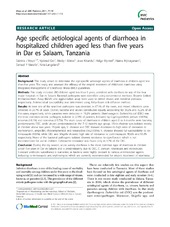| dc.description.abstract | Background This study aimed to determine the age-specific aetiologic agents of diarrhoea in children aged less than five years. The study also assessed the efficacy of the empiric treatment of childhood diarrhoea using Integrated Management of Childhood Illness (IMCI) guidelines. Methods This study included 280 children aged less than 5 years, admitted with diarrhoea to any of the four major hospitals in Dar es Salaam. Bacterial pathogens were identified using conventional methods. Enzyme Linked Immunosorbent Assay (ELISA) and agglutination assay were used to detect viruses and intestinal protozoa, respectively. Antimicrobial susceptibility was determined using Kirby-Bauer disk diffusion method. Results At least one of the searched pathogens was detected in 67.1% of the cases, and mixed infections were detected in 20.7% of cases. Overall, bacteria and viruses contributed equally accounting for 33.2% and 32.2% of all the cases, respectively, while parasites were detected in 19.2% patients. Diarrhoeagenic Escherichia coli (DEC) was the most common enteric pathogen, isolated in 22.9% of patients, followed by Cryptosporidium parvum (18.9%), rotavirus (18.1%) and norovirus (13.7%). The main cause of diarrhoea in children aged 0 to 6 months were bacteria, predominantly DEC, while viruses predominated in the 7-12 months age group. Vibrio cholerae was isolated mostly in children above two years. Shigella spp, V. cholerae and DEC showed moderate to high rates of resistance to erythromycin, ampicillin, chloramphenicol and tetracycline (56.2-100%). V. cholerae showed full susceptibility to co-trimoxazole (100%), while DEC and Shigella showed high rate of resistance to co-trimoxazole; 90.6% and 93.3% respectively. None of the bacterial pathogens isolated showed resistance to ciprofloxacin which is not recommended for use in children. Cefotaxime resistance was found only in 4.7% of the DEC. Conclusion During the dry season, acute watery diarrhoea is the most common type of diarrhoea in children under five years in Dar es Salaam and is predominantly due to DEC, C. parvum, rotaviruses and noroviruses. Constant antibiotic surveillance is warranted as bacteria were highly resistant to various antimicrobial agents including co-trimoxazole and erythromycin which are currently recommended for empiric treatment of diarrhoea. | en_US |

